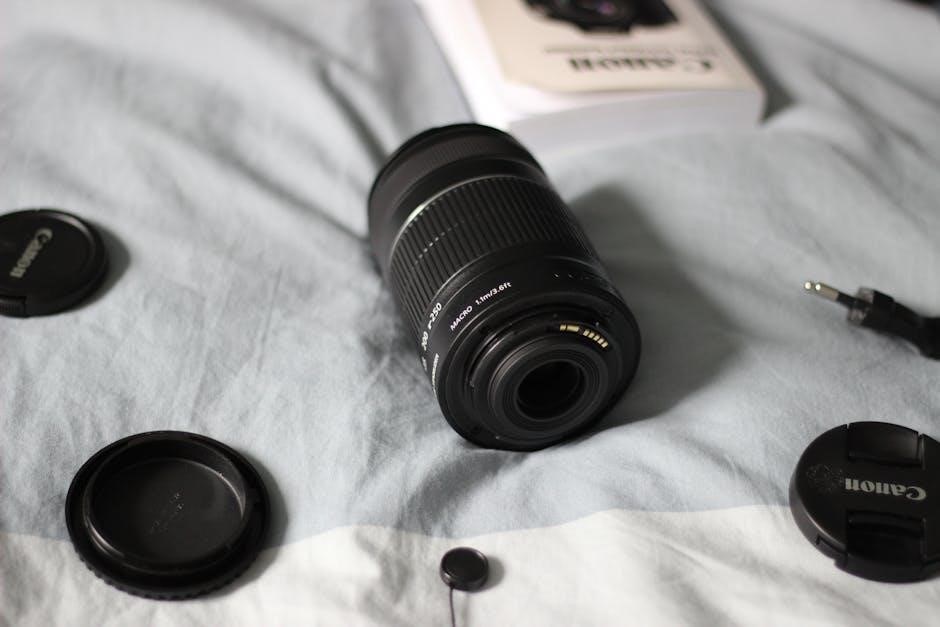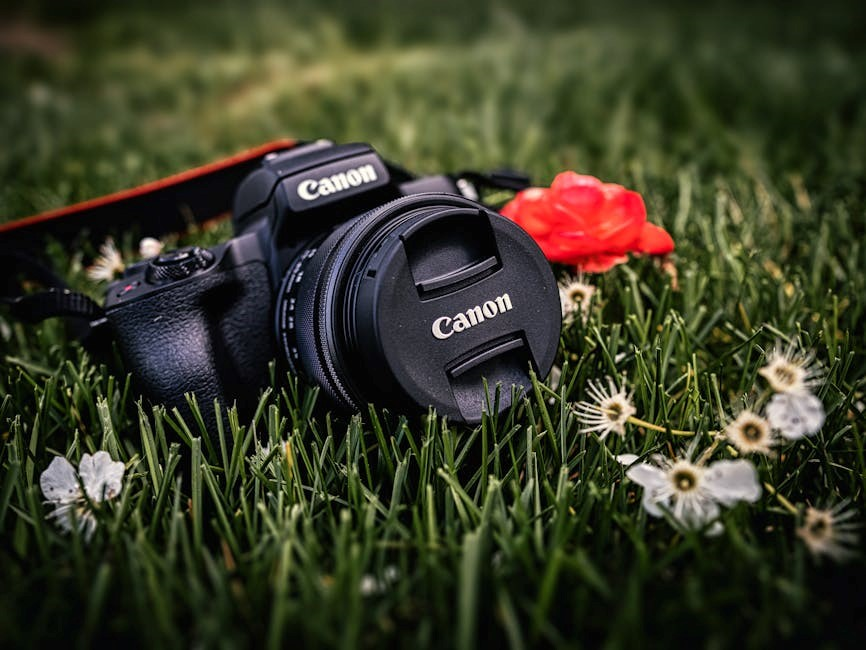Welcome to the Canon Rebel XT camera manual‚ your comprehensive guide to mastering this versatile DSLR. Discover key features‚ setup‚ and practical tips for optimal photography.
Overview of the Canon Rebel XT Camera
The Canon Rebel XT‚ also known as the EOS 350D‚ is a high-performance DSLR camera designed for versatile photography. It features an 8.0 MP CMOS sensor‚ DIGIC II image processor‚ and compatibility with Canon EF-S lenses. Known for its compact design and user-friendly interface‚ the Rebel XT appeals to both enthusiasts and professionals. The camera supports advanced shooting modes‚ including manual controls‚ and offers a wide ISO range for low-light conditions. Its ergonomic build and intuitive controls make it easy to handle‚ while the inclusion of EOS Utility software enhances functionality. This camera is a popular choice for capturing high-quality images with precision and creativity‚ making it a reliable tool for photographers seeking excellent performance in various settings.
Importance of the Manual for Optimal Camera Use
The Canon Rebel XT manual is essential for unlocking the camera’s full potential. It provides detailed instructions on operating modes‚ custom settings‚ and troubleshooting‚ ensuring users can optimize their photography experience. By understanding the manual‚ photographers can master advanced features like exposure control and white balance‚ leading to better image quality. The guide also covers maintenance tips‚ such as cleaning and proper storage‚ to prolong the camera’s lifespan. Additionally‚ it explains how to use EOS Utility software for enhanced functionality. Whether you’re a novice or an experienced shooter‚ the manual serves as a valuable resource for getting the most out of your Rebel XT‚ helping you achieve professional-grade results in various shooting conditions.

Canon Rebel XT Camera Specifications
The Canon Rebel XT features an 8.0MP APS-C sensor‚ DIGIC II processor‚ 2.4″ LCD‚ and supports CF cards. It offers various shooting modes and manual controls for versatility and creative freedom‚ ensuring high-quality images in diverse photography scenarios.
Technical Specifications and Features
The Canon Rebel XT boasts an 8.0-megapixel CMOS sensor and a DIGIC II image processor‚ ensuring crisp and detailed images. It features a 2.4-inch LCD screen for previewing shots and reviewing images. The camera supports CompactFlash (CF) cards‚ including CF I and CF II‚ offering ample storage options. With a built-in flash and hot shoe mount‚ it provides versatile lighting solutions. The Rebel XT also includes 12 shooting modes‚ such as Auto‚ Manual‚ and several scene modes‚ giving users flexibility in various photography situations. Its ergonomic design and lightweight construction make it easy to handle for extended shooting sessions. This combination of features makes the Rebel XT a powerful tool for photographers of all skill levels. The camera’s compatibility with Canon EF-S lenses further enhances its capabilities‚ allowing for a wide range of creative possibilities. Additionally‚ the Rebel XT supports the EOS Utility software‚ enabling tethered shooting and image transfer to a computer for advanced workflows. Overall‚ the Rebel XT’s technical specifications and features make it a well-rounded and reliable choice for capturing high-quality images.
Image Quality and Sensor Details
The Canon Rebel XT features an 8.0-megapixel CMOS sensor‚ delivering high-resolution images with excellent clarity and detail. The DIGIC II image processor enhances color accuracy and noise reduction‚ ensuring vibrant and lifelike photographs. The sensor captures images in various formats‚ including JPEG and RAW‚ providing flexibility for post-processing. With a maximum resolution of 3456 x 2304 pixels‚ it produces sharp and detailed shots suitable for enlargement. The Rebel XT also supports a wide range of ISO settings‚ from 100 to 1600‚ allowing for optimal performance in different lighting conditions. Its 24-bit color depth ensures rich tonal gradations‚ making it ideal for capturing intricate details in both bright and low-light environments. This combination of sensor technology and image processing power makes the Rebel XT a reliable choice for photographers seeking high-quality results. The camera’s ability to balance detail and noise ensures professional-grade imagery‚ catering to both enthusiasts and professionals alike.
Build and Design Overview
The Canon Rebel XT boasts a lightweight yet durable design‚ with a compact body made of stainless steel and aluminum alloy. Weighing approximately 510 grams‚ it offers a comfortable grip and ergonomic controls‚ making it easy to handle during extended shoots. The camera features a 1.8-inch TFT LCD screen with 115‚000 pixels‚ providing clear image playback and menu navigation. The intuitive control layout includes a mode dial‚ command dial‚ and buttons for quick access to settings like ISO‚ white balance‚ and autofocus. Built with a rugged construction‚ the Rebel XT is designed to withstand regular use‚ while its compact size makes it portable for on-the-go photography. The design emphasizes functionality‚ ensuring easy operation for both beginners and advanced users. Its sleek and professional appearance reflects its high-quality engineering‚ making it a reliable tool for capturing exceptional images. The Rebel XT’s build and design strike a perfect balance between durability‚ comfort‚ and functionality.

How to Use the Canon Rebel XT Manual Effectively
Utilize the manual’s structured sections‚ like the table of contents and troubleshooting guide‚ to enhance your understanding and optimize camera functionality for exceptional photography results.
Navigating the Manual: Table of Contents and Index
The Canon Rebel XT manual features a detailed table of contents and index‚ allowing quick access to specific topics. The table of contents organizes information logically‚ from camera setup to advanced techniques‚ ensuring easy navigation. The index provides a comprehensive list of terms‚ enabling users to locate information swiftly. By familiarizing yourself with these sections‚ you can efficiently find guidance on troubleshooting‚ camera customization‚ and maximizing functionality. This structured approach ensures that photographers of all skill levels can navigate the manual with ease‚ making it an indispensable resource for optimizing your Rebel XT experience.
Understanding Symbols and Conventions Used
The Canon Rebel XT manual uses specific symbols and conventions to guide users effectively. Common symbols include f for aperture‚ ” for shutter speed‚ and ISO for sensitivity settings. Modes like Auto‚ Manual‚ Av‚ and Tv are clearly indicated. Error messages and warnings are highlighted with distinct icons or bold text for quick recognition. The manual also employs color-coded sections and numbered lists for clarity. Familiarizing yourself with these conventions ensures seamless navigation and helps you interpret instructions accurately. Understanding these symbols and notations is crucial for maximizing your camera’s potential and resolving issues efficiently. Always refer to the manual when encountering unfamiliar symbols or terminology.
Troubleshooting Common Issues
The Canon Rebel XT manual provides detailed solutions for common issues‚ such as error codes and camera malfunctions. Familiarize yourself with error messages like ERR 99‚ which often indicates communication problems between the camera and lens. A blank LCD screen may signal a power issue or sensor cleaning. Memory card errors can be resolved by formatting or replacing the card. Lens problems‚ such as failure to autofocus‚ may require cleaning or professional servicing. The manual also guides you through resetting the camera to default settings if needed. Always refer to the troubleshooting section for step-by-step solutions to ensure your camera operates smoothly and efficiently. Regular maintenance‚ as outlined in the manual‚ can prevent many of these issues from occurring.

Setting Up and Configuring Your Canon Rebel XT
Setting up your Canon Rebel XT involves unboxing‚ charging the battery‚ and inserting a memory card. Use the manual to navigate features and configure settings. Utilize EOS Utility software for enhanced functionality and personalized camera setup.
Initial Setup: Unboxing and Preparing the Camera

Unboxing your Canon Rebel XT‚ you’ll find the camera body‚ EF-S 18-55mm lens‚ battery‚ charger‚ and manual. Begin by charging the battery fully before first use. Insert a compatible memory card‚ ensuring it’s formatted in-camera for optimal performance. Familiarize yourself with the camera’s exterior‚ including the mode dial‚ shutter button‚ and LCD screen. Refer to the manual for detailed diagrams and descriptions. Before shooting‚ set the date‚ time‚ and language preferences via the menu. Update the firmware if necessary using the EOS Utility software. Properly attaching the lens and ensuring all components are securely connected is crucial for camera functionality. This initial setup ensures a smooth start to your photography journey.
Customizing Camera Settings for Personalized Use
Customizing your Canon Rebel XT allows you to tailor settings to your photography style. Start by exploring the mode dial‚ selecting options like Auto‚ Program AE‚ or Manual for creative control. Use the Picture Styles to adjust color tones and sharpness‚ ensuring your images meet your artistic vision. Customize AF modes‚ such as One-Shot or AI Servo‚ for precise focus control. Metering modes‚ like Evaluative or Spot‚ can also be adjusted for accurate exposure. Additionally‚ assign frequently used functions to buttons for quick access. Experiment with custom functions to refine settings like noise reduction or flash exposure. Regularly updating firmware via EOS Utility ensures you have the latest features and improvements. Personalizing these settings enhances your shooting experience and helps you achieve consistent results.
Using EOS Utility Software for Enhanced Functionality
EOS Utility software enhances your Canon Rebel XT experience by providing advanced camera control and image management. Download and install the software from Canon’s official website to access features like remote shooting and image transfer. Use the Remote Live View function to preview shots on your computer‚ ensuring precise framing. Adjust settings such as aperture‚ shutter speed‚ and ISO directly from the software for seamless control. Transfer images wirelessly or via USB‚ and organize them efficiently. EOS Utility also allows firmware updates‚ ensuring your camera stays up-to-date with the latest features. This tool is essential for professional photographers seeking enhanced functionality and streamlined workflows. Regular updates improve performance and compatibility‚ making it a valuable resource for Rebel XT users. Use it to unlock your camera’s full potential.

Shooting Modes and Techniques
Explore various shooting modes and techniques to enhance your photography skills with the Canon Rebel XT‚ from automatic to manual settings for creative control and precision.
Understanding Auto and Manual Modes
Mastering the Canon Rebel XT’s shooting modes is essential for capturing stunning images. The camera offers both Auto and Manual modes‚ catering to all skill levels. Auto mode simplifies photography by automatically adjusting settings‚ ideal for beginners or quick shots. Manual mode‚ on the other hand‚ provides full control over aperture‚ shutter speed‚ and ISO‚ allowing for creative freedom and precision. The manual explains how to transition between these modes seamlessly‚ ensuring optimal results in various lighting conditions. Whether you’re a novice or an experienced photographer‚ understanding these modes will enhance your ability to capture life’s moments with clarity and artistry.
Exposure Control: Aperture‚ Shutter Speed‚ and ISO
Exposure control is the cornerstone of photography‚ and the Canon Rebel XT manual provides detailed insights into mastering aperture‚ shutter speed‚ and ISO. Aperture regulates light entry and depth of field‚ with lower f-stops opening the lens wider for a shallower focus. Shutter speed controls the duration light reaches the sensor‚ affecting motion blur and freeze. ISO sensitivity adjusts the sensor’s light response‚ balancing noise and low-light performance. The manual guides users through balancing these elements for optimal exposure‚ ensuring crisp‚ well-lit images in various scenarios. Understanding these fundamentals is key to unlocking the Rebel XT’s full potential and achieving professional-grade results.
Advanced Techniques: Focus‚ Metering‚ and White Balance
Mastering focus‚ metering‚ and white balance is essential for capturing stunning images with the Canon Rebel XT. The manual explains how to use autofocus modes like One-Shot AF for stationary subjects and AI Servo AF for moving objects. Metering options‚ such as Evaluative‚ Center-Weighted‚ and Spot‚ help achieve accurate exposure in various lighting conditions. White balance ensures color accuracy by adjusting settings like Auto‚ Daylight‚ or Cloudy. Custom white balance allows precise calibration for unique lighting scenarios. These advanced techniques‚ detailed in the manual‚ empower photographers to refine their skills and produce professional-quality images with ease and precision.

Maintenance and Care for the Canon Rebel XT
Regular cleaning‚ proper storage‚ and firmware updates ensure optimal performance. Use a soft cloth for the lens and camera body‚ store in a dry place‚ and update software regularly.

Cleaning the Camera and Lens
Regular cleaning is essential for maintaining your Canon Rebel XT’s performance. Use a soft‚ dry cloth to wipe the camera body and avoid harsh chemicals. For the lens‚ gently remove dust with a microfiber cloth or an air blower. Avoid touching the lens surface to prevent smudges. If necessary‚ use a lens cleaning solution with a microfiber cloth‚ ensuring no residue remains. Clean the viewfinder and LCD screen with a soft‚ dry cloth to avoid scratches. Store the camera in a protective case when not in use to minimize dust exposure. Proper cleaning ensures sharp images and prolongs your camera’s lifespan.
Proper Storage and Handling Practices
Store your Canon Rebel XT in a cool‚ dry place‚ away from direct sunlight and moisture. Use a padded camera bag or case to protect it from shocks and scratches. Avoid extreme temperatures‚ as they can damage the camera’s electronics. When not in use‚ remove the battery and store it separately to prevent corrosion. Keep the lens cap on to protect the lens from dust and fingerprints. Handle the camera with clean‚ dry hands to avoid transferring oils to the lens or body. For long-term storage‚ use silica gel packets to absorb moisture. Proper storage ensures your camera remains in excellent condition and ready for use whenever needed.
Updating Firmware and Software
Regularly updating your Canon Rebel XT’s firmware and software ensures optimal performance and access to the latest features. Use the EOS Utility software to check for and install firmware updates. Connect your camera to a computer via USB‚ launch the EOS Utility‚ and follow the on-screen instructions. Ensure the camera’s battery is fully charged and avoid interrupting the update process. Additionally‚ keep the EOS Utility software updated to maintain compatibility and functionality. Firmware updates often improve camera performance‚ fix bugs‚ and enhance compatibility with lenses and accessories. Always download updates from Canon’s official website to ensure security and authenticity. Updating your camera and software is essential for maximizing its capabilities and maintaining peak performance.

Accessories for the Canon Rebel XT
Discover essential accessories like compatible lenses‚ flash units‚ and additional gear to enhance your photography experience with the Canon Rebel XT camera.
Compatible Lenses and Flash Units
The Canon Rebel XT is compatible with a wide range of EF-S and EF lenses‚ offering versatility for various photography needs. Popular options include the EF-S 18-55mm kit lens and telephoto lenses for distant subjects. Additionally‚ the camera supports external flash units like the Speedlite 580EX II‚ which integrates seamlessly with the Rebel XT’s E-TTL II flash metering system. Using genuine Canon accessories ensures optimal performance and compatibility‚ enhancing both functionality and image quality. These accessories are designed to meet the needs of photographers‚ from casual shooters to professionals‚ providing tools to capture stunning images in diverse lighting conditions.
Additional Accessories for Enhanced Photography
Beyond lenses and flash units‚ the Canon Rebel XT supports various accessories to elevate your photography experience. Remote controllers like the RC-1 enable wireless shutter release‚ minimizing camera shake for sharper images. The BG-E3 battery grip provides extended shooting sessions and improved ergonomics. Tripods and monopods are essential for stability‚ especially in low-light conditions. Filters‚ such as UV and polarizing options‚ protect your lens and enhance image aesthetics. Memory cards‚ including high-capacity CF cards‚ ensure ample storage for your photos. These accessories‚ along with the EOS Utility software‚ expand the Rebel XT’s capabilities‚ allowing for more creative control and efficient workflow management. They cater to both amateur and professional photographers‚ ensuring every shot is captured with precision and ease.

Troubleshooting and Error Messages
Resolve common issues with the Canon Rebel XT by understanding error codes and alerts. Refer to the manual for solutions to ensure your camera operates flawlessly.
Common Errors and How to Resolve Them
The Canon Rebel XT may display error codes like E0001 or E0010‚ indicating issues such as lens errors or memory card problems. To resolve these‚ restart the camera‚ clean the lens contacts‚ or format the memory card. For E0001‚ ensure the lens is properly attached. For E0010‚ check the memory card for damage or formatting issues. If errors persist‚ update the firmware or contact Canon support. Regular maintenance‚ like cleaning the sensor and updating software‚ can prevent many common issues. Always refer to the manual for specific troubleshooting steps to maintain optimal camera performance and image quality.
Understanding Error Codes and Alerts
The Canon Rebel XT displays error codes to alert users of specific issues. Common codes like E0001 or E0010 indicate problems such as lens errors or memory card malfunctions. These codes guide users to resolve issues efficiently. For example‚ E0001 often relates to lens communication problems‚ while E0010 may signal a memory card error. Understanding these codes helps in troubleshooting effectively. Refer to the manual for a detailed list of codes and their meanings. If an error persists‚ restart the camera‚ clean the lens contacts‚ or format the memory card. For severe issues‚ updating the firmware or contacting Canon support may be necessary. Familiarizing yourself with these alerts ensures smoother operation and minimizes downtime during photography sessions. Always consult the manual for precise solutions to maintain your camera’s performance.
Thank you for exploring the Canon Rebel XT manual. With its comprehensive guide to features‚ techniques‚ and troubleshooting‚ this manual empowers you to master your photography journey.
Final Tips for Mastering the Canon Rebel XT
To fully master the Canon Rebel XT‚ practice regularly and explore its features. Start by familiarizing yourself with the camera’s settings and modes. Experiment with different shooting techniques‚ such as manual focus and white balance adjustments‚ to enhance your photos. Use the EOS Utility software to transfer images and customize settings for a personalized experience. Regularly clean and maintain your camera to ensure optimal performance. Stay updated with the latest firmware to access new features and improvements. Finally‚ refer to the manual whenever you encounter unfamiliar functions or errors. With consistent practice and a deep understanding of the camera’s capabilities‚ you’ll unlock your full creative potential with the Canon Rebel XT.
